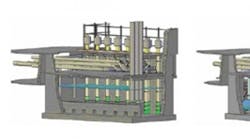The University of Cincinnati’s (UC’s) central utility plant provides steam, chilled water, and power for the UC academic campus, a medical complex, and area hospitals. It opened in 1992 as a gas-fired steam plant serving the campus. About a decade later, UC commissioned additional house chillers and a twin-turbine cogeneration system to produce electricity, with leftover heat recycled into the steam system. The plant was completed and put into commercial service in May 2004. It contains:
• Two 12.5-MW combustion turbine generators, which can operate on both natural gas and diesel fuel.
• Two heat-recovery steam generators capable of producing a total of 240,000 lb of 600-psi steam at 750°F per hour.
• A 24-MW steam turbine.
• Two 150,000-lb-per-hour dual-fuel package boilers.
• 18,000 tons of chiller capacity.
• 20,000 tons of chillers, pumps, and auxiliary equipment.
The system originally was configured with rooftop cooling towers with catch basins, as opposed to retention basins. After moving through the towers, condenser water is gravity fed to an underground open sump in the subbasement of the new plant.
Excess Energy Consumption
The original installation included nine Peerless vertical turbine condenser-water pumps ranging from 250 hp to 450 hp. The pumps pulled suction supply from the open sump and had to overcome 120 ft of static head to move condenser water to the top cooling-tower distribution headers. Total design head for all pumps was 150 ft to 175 ft.
An evaluation of the operation demonstrated that significant savings could be achieved by piping the cooling towers into a closed-loop condenser-water system, recovering 100 ft of static suction pressure from the cooling towers.
The Solution
UC, along with Fosdick & Hilmer Inc. (Cincinnati-based provider of engineering, project-management, and related services), Corporate Equipment Co. (Cincinnati-based provider of engineered-pumping-equipment repair, sales, and service), and the local Peerless Pump representative, developed a plan to install flanged suction manifolds on the pumps to accommodate the new closed-loop condenser-water system. To meet reduced head requirements, the two-stage vertical turbine pumps were destaged to single-stage units.
New stainless-steel piping headers were installed in the old open sump and connected to the flanged suctions of the reconfigured pumps. The original 4,160-v motors were reused and today operate at 50 percent of their design power consumption. The pumps were modified at the Peerless Pump factory in Indianapolis in 2010, during UC’s winter break.
Small Modification, Big Savings
The recommissioned system will reduce UC’s annual electricity use by 2.5 million kwh. The reduction in energy use will lower carbon-dioxide emissions by 5.25 million lb. With annual energy-cost savings of $177,000 anticipated, the project should pay for itself in five years.
Overall, the changes to the system have helped UC to realize its vision of exceeding the needs and expectations of the university community by providing the most reliable and cost-effective utilities.
Information and images courtesy of Peerless Pump Co.
For Design Solutions author guidelines, call Scott Arnold, executive editor, at 216-931-9980, or write to him at [email protected].










